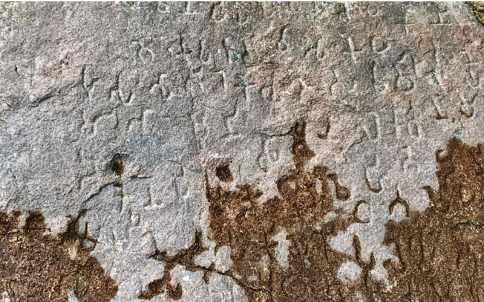Dr. M. Suresh Babu, President, Praja Science Vedika
Historic rock inscriptions between 10000 to 6000 BC have been found in a neglected state in Rayalaseema Districts.
The caves, located at Kethavaram of Orvakal mandal, are home to rock art which dates to the Palaeolithic age. Paintings of deer, bulls, foxes, rabbits, and humans made by ancient inhabitants of the caves have been a hit among locals for a while now. The Ketavaram rock paintings are dated back to the Paleolithic era.
Kethavaram rock art is prehistoric

However, minimal connectivity has proven to be a concern. The proposals made by the District authorities to lay new roads leading to the caves and are confined to papers. The DWMA would see to it that avenue plantations happen promptly and conservation works would be taken care of by the Archaeology department. The authorities are not planning to approach UNESCO to get proper certifications. There is no proper publicity to bring the Kethavaram Caves a major attraction and in turn generate jobs for the locals. The prehistoric Kethavaram rock art, which dates back to the period between 10,000 and 6,000 BC, is yet to get Unesco recognition as a heritage and cultural site despite crores of rupees having been spent to develop the caves and related facilities. The caves, located at Kethavaram in Orvakal mandal, were carved in the Mesolithic period with the rock art of deer, bulls, foxes, rabbits, turtles, butterflies, hyenas, crocodiles and humans. It was discovered by a team of researchers from the ancient history and archaeology wing of the University of Madras in 2018. The team identified around 40,000 such paintings in the area, making it the largest such area in South India.
Kethavaram rock paintings the thematic emphases an animal’s in the rock paintings at kethavaram. The group of pictures depicted the lifestyle of pre historic man. The animals which found prominently among the figures are deer, staf, antelope, hyena, rabbit, reptile and frog.
Efforts made to increase accessibility, conservation
Historical paintings of this phase occur in only one rock shelter and they comprise five paintings. Though the paintings have survived the vagaries of nature for over 5000 years, it might not be so in future with increased human activity disturbing the ambience. It’s a shame that despite the rich historical and cultural significance of the Kethavaram Caves, they haven’t yet received the UNESCO recognition they deserve. It’s heartening, though, to hear about the efforts being made to improve accessibility and conservation. Hopefully, with these initiatives, the caves will gain the attention they need to become a world heritage site, bringing not only recognition but also economic opportunities for the local community. The rock art, showcasing the lifestyle of prehistoric man, sounds like a treasure trove of history.

On a stone built in the back wall of the ruined temple of Prasannayya, Bollavaram, Nandikotkuru Taluk, Kurnool District. S. 1619. (Isvara)
Records the gift of land by Goparaju Prasannayya, Sthala-karanam of Bollavaram, to Krishnayya, Karanam of Prolukallu while Aurang Padsha was ruling at Amudanagaram, another name for Hastinapuram (Delhi).
This is dated Sobhakrit, Nija-Sra[vana]. The other details are lost. As the gift was made on the occasion of Krishnashtami, the tithi and the date may be equated to 1543, August 23, Wednesday.
It registers the grant of tolls (penta-sunkham) of the village Bollavaram in Guddaluri-sima by Papa Timmayadeva-maharaju, son of Mahamandalesvara Ramaraju Timmaraju of lunar race and Atreya-gotra to god Gopikanatha-Perumal for offerings on the occasion of Krishnashtami. Guddaluri-sima is said to be the nayankara territory of the donor.
Ashoka’s rock edicts
Ashoka’s rock edicts were inscribed in 3rd-century BCE. The inscription is in Prakrit language and Brahmi script. Both the major and minor edits are found at Erragudi. The site consists of a hillock, with many rocky boulders in rural, remote part of peninsular India, near the Andhra Pradesh – Karnataka border. The inscriptions are found on several rocks, written left to right, typically wrapping along the natural curvature of the rock. Some are clearly visible from a distance. Others are a bit faded due to natural erosion, and need closer inspection to find them. No intentional damage is visible at this site. These are among the oldest discovered and dated inscriptions in India. The site is an ASI protected site under Indian laws.

Budagavi, a small historic village
Budagavi is a small village situated in the uravakonda talk of anantapur district, about 6 km from the talk headquarters on the Anantapur -Ballari road. the granite hillock at many places on its flat top and slopes revealed evidences of mesolithic and Neolithic tools. The site was discovered by Robert Bruce Foote. The Neolithic habitation site thought no excavation were conducted here a large surface collection of Neolithic artifacts pottery and mesolithic tools was reported. The total number of rock paintings in all the four rock shelter is 20. Rock shelter 2 are in white colour. the white paintings comprise drawings of two human figures one in flat wash and another in outline, in a standing posture side by side. the paintings in red ochre depict a deer humped bulls handprints geometric figures and human figures. (local people called is paintings rathapatallu ) Budagavi is a beautiful rock shelter
World Heritage Sites are designated by UNESCO for having cultural, historical, scientific, or other forms of significance. Once a site is inscribed, a country may also receive financial assistance and expert advice from the World Heritage Committee to support activities for the preservation of such sites.





Excellent contributions! please visit NIT Nagaland. we will work together for similar studies in Nagaland duing the Mahabhratha and Narahasura period.